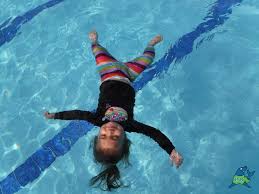 One of the most asked questions in swimming is, “Why can’t I float in water?” And, obtaining the answer can seem like a confusing mystery, especially when some people just jump in water and tread without moving a muscle. While others splash about, arms and legs moving rapidly, just to keep their heads above water. Then, we find out that much of this is due to the differences in our physiology. How annoying to think that some people are built in such a way that makes them better floaters than others. Truth is, there may be simple science behind this phenomenon, but it’s not the whole story.
One of the most asked questions in swimming is, “Why can’t I float in water?” And, obtaining the answer can seem like a confusing mystery, especially when some people just jump in water and tread without moving a muscle. While others splash about, arms and legs moving rapidly, just to keep their heads above water. Then, we find out that much of this is due to the differences in our physiology. How annoying to think that some people are built in such a way that makes them better floaters than others. Truth is, there may be simple science behind this phenomenon, but it’s not the whole story.
It has to do with the word density (the ratio of mass to volume). In physics when something is said to be dense, it means to have component parts closely compacted together. Mass is a body of coherent matter, and volume is an amount of space, measured in cubic units an object or substance occupies. https://www.dictionary.com. In other words, density describes how much space an object/substance takes up (its volume) in relation to the amount of matter in that object/substance (its mass). https://study.com/academy/less…
If an object has a greater density than water, it sinks. If it is less dense than water, it floats…So, as it turns out, athletes with very little body fat might have to work harder to stay afloat in the water. To be healthy, our bodies need a balance of fat and muscle. https://www.scientificamerican…
What Can You Do If You Have Difficulty Floating in Water?
The good news is that the human body’s weight is measured with two-thirds of it being water. This factor gives us an advantage in our ability to float. Obviously, those with more muscle mass may have a greater inclination to sink in water than those with a higher fat to muscle ratio, but don’t despair. Those with greater muscle mass have other resources at their disposal. Floating in water can be mastered by incorporating other techniques that can circumvent a lack of buoyancy such as relaxing and not panicking. When we panic, our muscles tend to tense up making the body denser = tendency to sink. So, stretching across the water as if we’re lying down in a bed and breathing deeply, will actually help to keep the body aloft. More oxygen in the body will make the body more buoyant. In the scientific equation described above, oxygen is less dense than water, therefore, having more oxygen in the lungs will give the body a better propensity to float. Another effective technique is to lift the lower body up and toward the water’s surface by using the core muscles. This will increase one’s floating ability as well. Please note, that it need not be a prefect prone position. Work on staying up, being comfortable and relaxed.
 Children age ten and under, can reasonably float well due to their ability to streamline their bodies in the water with ease. However, adjustments may need to be made once they begin to grow. This is due to maturation which causes their center of gravity and their center of buoyancy to shift. Their legs get longer and balancing themselves toward the surface of the water may require technique changes, similar to those discussed above, in order for them to stay afloat. If these children are comfortable in the water, say they’ve been swimming since infancy, these changes could be adopted relatively easily.
Children age ten and under, can reasonably float well due to their ability to streamline their bodies in the water with ease. However, adjustments may need to be made once they begin to grow. This is due to maturation which causes their center of gravity and their center of buoyancy to shift. Their legs get longer and balancing themselves toward the surface of the water may require technique changes, similar to those discussed above, in order for them to stay afloat. If these children are comfortable in the water, say they’ve been swimming since infancy, these changes could be adopted relatively easily.

Mind / Body Connection Regarding Floating in Water
Scientists have pondered this connection with what we think and how those thoughts affect the body for years. The mind-body connection has been primarily used for diagnosing and maintaining health and treatments for diseases. Stress has been linked with all types of ailments that were once only thought to have biological components. This is a factor that must be mentioned in order to fully understand floating in water.
Regardless of our muscle to fat ratio and whether we can float on water or not, how we react in water will affect our outcome of floating. For example, some people with low muscle density who should be buoyant, will sink in water because they tense up, making their body heavier. While others with greater muscle to fat ratios, but with more relaxed attitudes, will have better floating outcomes simply because their technique can keep them aloft. This factor should give hope to those who are struggling with their ability to float in water. This may sound cliché, but sometimes encouraging oneself is necessary.
An Ideal Weight for Swimmers to Maintain Buoyancy?
Many coaches believe that there is an ideal weight for ALL swimmers. Don’t change your diet just yet! This philosophy doesn’t take into consideration the physiological differences from one human being to another, nor their eating habits, or out of the water activities like weight training. If a swimmer bulks up their torso, this will change their center of gravity/buoyancy and may force them to dedicate more energy using their arms perhaps in order to maintain their correct floating posture.
For complete accuracy in knowing the ideal weight a swimmer needs in order to remain buoyancy, usually flotation tests are conducted. The City of Tempe’s rowing team float test requires rowers to float, tread water or swim in place for 10 minutes. The Boy Scouts of America tests participants on swimming with sharp turns in the water, testing their ability to stay afloat and then continue to swim. Bainbridge Island Aquatic Center has their children age 6 and under float or tread for 1 minute.
Final Comments and Floating Advantages
Floating in water has a calming effect, making the body feel lite as air. It is one of the first techniques that swimming instructors teach because knowing how to float can also save one’s life. Like so many other swimming techniques, practicing correct technique should increase ability. Please note that there are several styles of floating to try. Here are a few:
- Jellyfish floating style is curling the body up with the knees tucked to the chest and the back flat and slightly above the water. The head is submerged, but the swimmer can straighten up and breathe while treading. Then go back to the jellyfish float. This is a popular survival technique.
- Vertical float style is putting the body in a position perpendicular to the water, or in a standing position. This would be used when treading.
- Horizontal float style lying back or forward in the water in a prone position. Whether the face is in the water or face-up, try to remain calm, finning the arms gently to stay afloat.
Give one or all of these different styles a whirl, relaxing as you do so, remembering to breathe deeply. Also, always try these techniques in shallow water first in order to maintain safety at all times. Move your arms gently and flap your feet in order to assist with staying aloft as well. The Red Cross has a great Swimming and Water Safety guide for FREE download. Take a look!
Let’s face it, we can also enjoy floating in water by using a flotation device. It’s a wonderful way to ease tensions and relieve stress whether buoyancy comes naturally or by way of a small purchase. Either way works! Try a pull buoy. It’s normally used for arm drills, but it can be used to practice floating. It’s small, lite weight, easy to carry.
If this post has been helpful, please let us know.


Nice article…very informative
Glad it was helpful, Ed.
I liked that you touched on the mind-body connection when it comes to floating in the water. It is important to do so. You have to be in the right state of mind to float. Personally, I can only do it when I am calm.
That brings me to my question. Are there any health benefits to floating in the water? I know your article is not about that, but it seems to me to be an important question. I look forward to hearing your answer.
Thank you for sharing and I hope you make it a great day!
Alex, thank you so much for your comments and interests in floating. Let’s talk about benefits; because you are in a weightless position while floating, it allows the body to relax, relieving pressure on the muscles, tendons, increasing circulation, helping sufferers of migraines (neck tension), and those with rheumatoid issues also, to name a few. I love to float because it takes pressure off my back. I’ve entered the pool hunched over in pain and swam several laps without pain – as if the issue didn’t even exist!
We can talk to ourselves and accomplish much, that is why I love the fact that you mentioned being calm before floating. This is wisdom that can be used in and out of the pool. Most of the swimmers are know are calm people. Keep doing it and you won’t have to think about it at all, you’ll just lie down and immediately relax. Hope that this is helpful.
Bev-
Hi Beverly, I have to say I learned a few new things about floating. I also read your article on breathing. Both articles answered questions I had concerning swimming. Keep up the good work.
I’m a bit ashamed to say this, but I’m 16 and I still don’t know how to swim. It’s not that I don’t want to, it’s just because there aren’t many swimming pools near my area. I wish I could swim, though. I once tried to relax and float, but it seems like the more I relaxed my muscles, the more my body sinks.
Anyways, thanks for the insightful article!
First off, there is nothing to be ashamed of about not knowing how to swim at any age. It really doesn’t matter that others your age or even younger have started doing it before you. Swimming is an activity that you can do for a life time! So, with that said, all you need to do is find a place where you can take lessons. I don’t know where you live, but I would start with local parks, colleges, and recreation centers. Check out this page on Swimfolk – http://swimfolk.com/learn-to-swim It doesn’t have them all – yet, but it’s a start. If you don’t see one in your area, leave me a comment so we can help you find one. Floating has more to do with what you’re thinking than your muscles. The body follows the brain. For example, if you’re saying, “Relax, body. Relax!” you may be getting tenser. However, if you say, “I’m light as a feather. This water can supports me and hold me up. All bodies float to the surface,” you might float. Thanks for visiting Swimfolk!
Thanks Beverly for this great piece of article. Thanks to you, I was in the process of debating with my Orthopedist & Physical therapist Doctors on the relevancy of using hydro therapy as a mean to help me regain my physical ability and nerve issues after i was involved in a car accident.
After reading your article, I became open minded to the idea of using aqua-therapy as an option to assist me in regaining my physical ability versus having injection to cure my nerve pain and to overcome my physical limitations. I was able to suggest to my doctors the benefit that i might gain on using aqua-therapy to relieve pain and muscle spasm – To gain relaxation – To maintain or increase the range of joint movement. – To re-educate paralyzed muscles – To strengthen weak muscles and to develop their power and endurance.
To encourage walking and other functional and recreational activities. – To improve circulation (trophic condition of the skin) – To give to myself the encouragement and confidence in carrying out these exercises, thereby improving morale.
I am in favor of such treatment for it is less strenuous on my body and I am starting to improve slightly, many thanks for your insight.
Marc,
This is the best news ever! This is what this site is all about, helping people through something as simple as swimming and its many benefits. I’m so happy for you not having to take injections and such – THIS IS AWESOME NEWS!!! Keep up the good work! 🙂
Bev